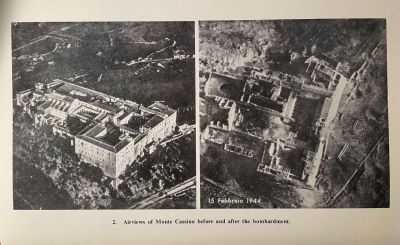This month I am continuing in the vein of “Art in Wartime” from last month’s La Gazzetta Italiana article with the addition of historical facts of the Italian Campaign in WWII as it pertains to the bombardment of the Benedictine Abbey and the town of Cassino.
After Italy surrendered to the Allied Forces in 1943, and the Fascist regime of Mussolini fell, Italy was occupied by German troops. Operation Avalanche by the Allies was launched in 1943 against Operation Axis and Nazi Germany. The Allies were headed to liberate Rome but the town of Cassino, located in central Italy, between Rome and Naples, stood in its path. And on its hilltop, 1,600 feet above the valley, stood the Benedictine Abbey, established in 530 AD by Saint Benedict.
Fearing the imminent destruction of the Abbey, under the direction of German and Austrian officers and Abbot Gregorio Diamare, the Abbey’s artifacts, approximately 800 Papal documents, 100,000 prints, 200 fragile parchment manuscripts, 80,000 volumes from the libraries, 500 incunabula (books printed, not handwritten before the 16th century), priceless art, and precious tapestries, some of which had originally been transferred from the Keats-Shelley house in Rome for safekeeping, were sent back to Vatican City and the Castel Sant’Angelo, a fortified fortress nearby. Nevertheless, some of the crates found their way into Germany. It was suspected that 15 cases containing property from the Capodimonte Museum in Naples were sent to high-ranking German officers.
Cassino, with some of the most rugged, mountainous terrain and bordered by rivers, is where the Germans held the Gustav Line to prevent the Allies from establishing airfields in Italy from which to attack Germany and the German-occupied Balkan states. This town found itself at the epicenter of the war in what would be the bloodiest battle. The historic, sacred Abbey, with 10 foot thick walls on seven acres, was regarded as off-limits to preserve artistic and cultural sites during wartime. The Germans were directed to stay away from its perimeter, so they hunkered down around the mountain.
Heavy losses in the river valley compelled the Allied Forces to focus on seizing the high ground of the Monte Cassino Abbey. Conflicting reports as to whether the Germans occupied the Abbey led to much disagreement among the generals. Major General Tuker (4th Indian Division) and Lieutenant General Freyburg (New Zealand) were calling for the bombardment of the Abbey while General Clark (U.S. Fifth Army) vehemently opposed the action. Ultimately, General Alexander (Britain) placed the order to attack.
On February 14, instead of Allied Forces calling a truce to safely evacuate the people in the monastery, leaflets were air-dropped by the Psychological Warfare Department Branch of the 5th Army Headquarters to warn Abbot Diamare, a few monks, and at a minimum of 800 refugees, to leave at once, knowing they would be unable to seek safety. On the morning of February 15, the Allies’ Operation Avenger launched 250 bombers, and 1,400 tons of bombs, in repeated attacks, leaving the monastery in ruins. Only a few survived; the Abbot and monks in the underground shelter and a few refugees. The ruins became a fortress for the German forces to hide among the rubble, prolonging the fight another three months. On May 15 the town itself was destroyed.
By May 18 the Germans withdrew, and the decimated Polish Corps, who lost over 1,000 men, raised their flag where the Abbey once stood. Considered an Allied victory in WWII, the Allies sustained 55,000 casualties, the Germans 20,000 and 2,000 civilians died on that mountain during the Battle of Cassino from January through May 1944.
The Allied Forces entered, bombed, and liberated Rome on June 4, 1944. Mussolini was captured by the Italian Resistance and executed in April 1945. World War II raged on until September 1945.
Generals Freyburg, Tuker, and Alexander all stood by the order for the bombing of Monte Cassino despite General Clark calling it a grave blunder and a black spot on the Allied Forces. Signed declarations by survivors of the bombardment, including Abbot Diamare, attested that no German troops were ever stationed within the walls of the Abbey. The conflicting reports still stand today. President Franklin D. Roosevelt promised to help rebuild but that promise was never kept. The Italian government paid for it all and began rebuilding in the 1950s. It was consecrated by the Pope in October 1964. The Abbey is occupied once again and the town now has a university, founded in 1979.
The town of Cassino is near my family’s hometown. In January 1944, my mother was barely 14 years of age when the Polish Corps were in her town of Civitanova del Sannio seeking food and shelter before moving on to Cassino. A Polish officer told my grandfather he would return with his son, an officer, to have my mother’s hand in marriage. We can only assume that they were among the 1,000 or so Polish soldiers who died on that mountain; for they never returned. She often reminisces, tells the story, and wonders.



